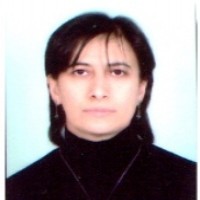Issue Editorial Board




Aim & Scope
Turquoise International Journal of Turkic World Scientific Research aims to contribute to the production and dissemination of scientific knowledge by creating a scientific platform where original scientific studies carried out in the fields of education, language, literature, social science, art and sports in the Turkic World and scientific research on the Turkic World can be published, It is an international peer-reviewed scientific academic journal published online twice a year.
Turquoise International Journal of Turkic World Scientific Research is an internationally refereed scientific academic journal published online twice a year, aiming to contribute to the production and dissemination of scientific knowledge by creating a scientific platform where original scientific studies in the fields of education, language, literature, social sciences, art and sports in the Turkic World and scientific research on the Turkic World can be published.
Author Guidelines
ARTICLE WRITING RULES
Page Layout: Articles should be written on A4 page size with 2.5 cm margins on all sides.
Title and Footnotes: The article title should be written justified, 14 point, bold and in Cambria font. The title should be a maximum of 15 words, and the first letter of each word, except for conjunctions, should be written in capital letters. In articles written in Turkish, the English title of the article should be written in the same manner. Special issues that need to be stated about the article will be explained at the bottom of the page with an (*) in the title after the article is accepted. After the study is accepted, the name and surname of the author(s) will be written in bold, 12 point, Cambria font, with the surname in capital letters and centered, and if the number of authors is more than one, in the order determined by the authors. Along with the title of the author(s), the full name of the place of employment, city-country information, e-mail address and ORCID number should be included as a footnote on the first page of the article. All information in footnotes should be in Palatino Linotype font, without indentations and in 10-point font.
Article Writing Language: Turkish and English studies are accepted for publication in the journal. In studies prepared in Turkish, a Turkish abstract should be included in Cambria font, 10-point font, not exceeding 200 words, and an English short abstract should be included, not exceeding 300 words. Similarly, in studies prepared in English, a Turkish short abstract should be included. 3-5 keywords should be included under the Turkish and English short abstracts.
Sections and Subsections: In studies, main section headings (first-level headings) should be numbered with Arabic numerals and written in Cambria font, 12-point font, bold, left-aligned and all capital letters. Subsection headings (second-level headings) should be written in Cambria font, 11-point font, bold, left-aligned, with the first letter of each word capitalized. Third level headings should be written in Cambria, 11 point, bold, italic, left aligned, only the first letter of the first word should be capitalized. The main text in the studies should be written in Cambria 11 point.
Paragraphs in the text should consist of at least three sentences and a line space should be left between paragraphs. Similarly, a line space should be given before and after the headings. There should be no indentation throughout the article, and the spacing values before and after paragraphs should be 0. APA 6 writing style should be used in writing in-text citations, tables, figures and bibliography.
In studies, INTRODUCTION, METHOD (Universe and sample/study group etc.), Data collection methods/techniques/tools and analysis of data), FINDINGS, DISCUSSION, CONCLUSION AND RECOMMENDATIONS and REFERENCES sections should be included according to the nature of the research. However, authors may create different sections if they feel necessary depending on the nature of the research. Sections should not be started on a new page, and after a section is completed, the next section should follow on the same page. APA 6 writing style should be used in the writing of the entire text of the article.
Figures and Tables: Figures can be placed in appropriate places in the article, centered, without overflowing the writing area. The figure should be referred to from the main text and, if possible, the figure should be explained. A figure title numbered in Arabic numerals should be placed under each figure, the same numbering should continue throughout the article and should be written in accordance with the APA 6 writing style. Figure titles should be written in Cambria font, 10 points, left aligned, with only the first letter of the first word capitalized. If a source is used in the figure title, the source information should be added in parentheses. If there is text in the figure, it should be written in Cambria font, 9 or 10 points.
Tables should be prepared left aligned and using Cambria font throughout. The table title should be written in 10-point font, only the first letter of each word of the title should be capitalized, and the title should be given under the table number. APA 6 writing style should be used for tables. Tables should be cited in the text by indicating the table number and should be commented after the table is finished. Tables should be included where they are used in the text or on the following page. Relevant notes and sources can be stated under the table, after the phrases “Note:” or “Source:”. References: The sources used in the article should be given under the title “REFERENCES” and before the appendix(es), if any, in accordance with APA 6 writing style. All sources should be written in 11-point font, with 1 line space between each source, in Cambria font, justified, single-spaced, with the paragraph values before and after 0, without indentation. Since each source in the references is cited from within the text, it should be ensured that each source used in the text is also included in the references.
Appendixes: If necessary, an Appendix section can be created after the bibliography and before the extended summary. The appendixes referred to in the article should be included here. If more than one appendix is used, they should be numbered. Elements that can be given as tables or figures in the article should not be included in the “Appendixes” section.
Extended Abstract: The author can optionally include an extended English summary of 750-1000 words in the article, if any, after the Appendixes section, if not, after the References section. This summary should not contain subheadings and should reflect the basic ideas of the article. No direct quotations should be included in the extended abstract, no tables or figures should be used, and it should be prepared in 11-point Cambria font.
Ethical Principles and Publication Policy
Publication Ethics
The ethical duties and responsibilities listed below have been prepared by taking into account the guidelines and policies published by the Committee on Publication Ethics (COPE) as open access.
A publication process that supports the objective production and dissemination of scientific knowledge is followed in Turkuaz International Journal of Scientific Research on the Turkic World. The successful operation of this process is only possible if all stakeholders (publisher, editor(s), author(s), referee(s) and reader(s), etc.) comply with the standards regarding ethical principles. Therefore, all stakeholders of the journal publication process are expected to act in accordance with the ethical principles stated below:
Ethical Responsibilities of Authors
Ethical responsibilities of author(s) who submit articles for publication in Turkuaz International Journal of Scientific Research on the Turkic World:
Turquoise International Journal of Turkic World Scientific Research is a scientific-academic e-journal where original scientific studies are accepted for publication in Turkish and English. Therefore, author(s) should submit original studies for publication and should not submit articles published in other journals or sent for publication.
Author(s) should refer to the sources they use in their studies in accordance with ethical principles and scientific rules and regulations.
Names of individuals who do not contribute to the article should not be reported as authors, and requests to add, remove or change the order of authors should not be made after the article is uploaded to the system for publication.
If information or raw data regarding their articles is requested from author(s) during the evaluation process, this information and documents should be submitted to the editor.
Persons with conflicts of interest or common interests regarding the article for which publication application is made should be reported to the editors.
Author(s) should document that the rights to use the data they use in their articles, permissions regarding research-analysis or approvals of the participants on whom they conducted research have been obtained.
Authors must contact the editor to inform, correct or withdraw an error in their article that is in the evaluation and early appearance stage or published electronically.
With the ULAKBİM decision dated February 25, 2020, it was made mandatory for all branches of science to obtain separate ethics committee approval for clinical and experimental studies on humans and animals that require an ethics committee decision, and for the approval information to be stated and documented in the articles. After this date, articles prepared based on quantitative or qualitative research should include a statement on the first and last pages and methods sections stating that ethics committee approval was obtained, and the name of the ethics committee that granted the approval, the date of the decision and its number; in addition, a copy of the document showing the ethics committee decision should be uploaded to the system together with the article application. In studies that do not require ethics committee approval, this situation should be clearly stated in the Method section. In addition, information on the receipt of the informed consent/approval form in case reports should also be included in the article.
Authors must provide evidence in the article that they have been careful about ethical principles during the data collection process (such as obtaining permission from them to use documents such as scales, surveys, photographs, etc. of others). Articles must state that research and publication ethics and copyright regulations for intellectual and artistic works have been complied with. If the research was conducted on human and animal subjects, it must be stated that the research was conducted in accordance with international declarations, guidelines, etc.
Ethics committee approval is not requested from the author(s) for compilation articles. However, in articles that do not require an ethics committee decision, it must be stated on the first and last pages of the article and in the method section that an ethics committee decision is not required.
Ethical Responsibilities of Editors, Assistant Editors, and Field Editors
Editors strive to meet the information needs of referees, author(s), researchers, practitioners, and readers, to provide feedback when necessary, and to act in accordance with the principles of openness in issues that require correction or clarification during the publication process.
When making positive or negative decisions about articles, editors take into consideration the original value of the articles, their contribution to the field, the validity and reliability of the research method, the clarity of the narrative, and the purpose and scope of the journal.
Editors take submitted articles to the preliminary evaluation stage unless they have significant problems, take into consideration positive referee suggestions, and do not change decisions made by previous editors unless there are serious problems.
Editors apply the blind refereeing and evaluation process policies, which are among the publication policies of the journal, keep the identities of the referees confidential, and ensure that each article is evaluated impartially and within the time limit.
Editors evaluate the editors who receive the articles and They send the referees by taking into account their areas of expertise, and support the impartial and independent evaluations.
Editors are in search of a wide range of referee pools and their constant updating.
Editors prevent unscientific evaluations that do not comply with academic etiquette.
Editors ensure that the journal publication processes are carried out in accordance with publication policies and guidelines, inform those responsible for the process about developments in publication policies, and prepare training programs when necessary.
Editors maintain effective communication with everyone responsible for the publication process, and organize meetings at regular intervals.
Editors ensure that personal data in the evaluated articles are protected; they protect the individual data of the author, referee and readers.
Editors; They take care to protect human and animal rights in articles, they care about documenting the explicit consent of the participants of the article, they reject the article when they do not have ethical committee approval for the participants of the article, or permission in experimental research.
Editors take precautions against misconduct. When there are complaints about misconduct, they conduct an objective investigation and share the findings on the subject.
Editors ensure that errors, inconsistencies or misdirection in articles are corrected.
Editors protect the intellectual property rights of published articles, and defend the rights of the journal and author(s) in case of violation. They also take the necessary precautions to ensure that the content of published articles does not violate the intellectual property rights of other publications; they perform originality-similarity checks.
Editors take into account consistent criticisms of articles published in the Journal, and grant the author(s) of the criticized articles the right to respond.
Editors also consider studies that contain negative results. Editors examine complaints submitted to the Journal and make the necessary explanations and take the necessary measures to resolve problems related to legitimate complaints.
Ethical Responsibilities of Referees
The double-blind refereeing principle is applied in the article evaluation process of the Turkuaz International Journal of Turkish World Scientific Research, where the author(s) do not know the referees and the referees do not know the authors; referees cannot communicate directly with the authors; article evaluation forms and notes specified on the text and correction requests are sent to the author(s) by the editors through the journal management system. Referees who will evaluate articles submitted to the Turkuaz International Journal of Turkish World Scientific Research are expected to comply with the following ethical principles:
Referees must accept to evaluate only articles related to their field of expertise.
Referees must conduct the evaluation with impartiality and confidentiality. According to this principle, they should destroy the articles they have reviewed after the evaluation process, but use them after they are published. Nationality, gender, religious belief, political belief and commercial concerns should not compromise the impartiality of the evaluation.
When referees understand that there is a conflict of interest or unity of interest, they should refuse to evaluate the article and inform the editors.
Referees should evaluate the article in a constructive manner, in accordance with academic etiquette; they should avoid personal comments that contain insults and hostility.
Referees should evaluate the article they accept to be evaluated within the time limit.
Reporting Situations That Do Not Comply with Ethical Principles
If any behavior that does not comply with ethical principles is encountered in the Turkuaz International Journal of Turkish World Scientific Research regarding editors, referees, authors, or an unethical situation is detected regarding an article in the evaluation process, in early view, or published, it should be reported to edt.turkuaz@gmail.com.
Price Policy
Dergimize yayınlanmak üzere sunulan yazılar için sunum, değerlendirme ve yayınlanma aşamalarında herhangi bir ücret talep edilmemektedir. Ayrıca dergimizde yayınlanan tüm makalelere ücretsiz ve sınırsız erişim imkanı sunulmaktadır.
Derginin tarandığı indeksler: ASOS İndeks, CiteFactor, ERIH PLUS , Eurasian Scientific Journal Index (ESJI) Directory of Research Journals Indexing (DRJI)
Turquoise International Journal of Scientific Research of the Turkic World is licensed under Attribution-NonCommercial (CC BY-NC) 4.0 International License


